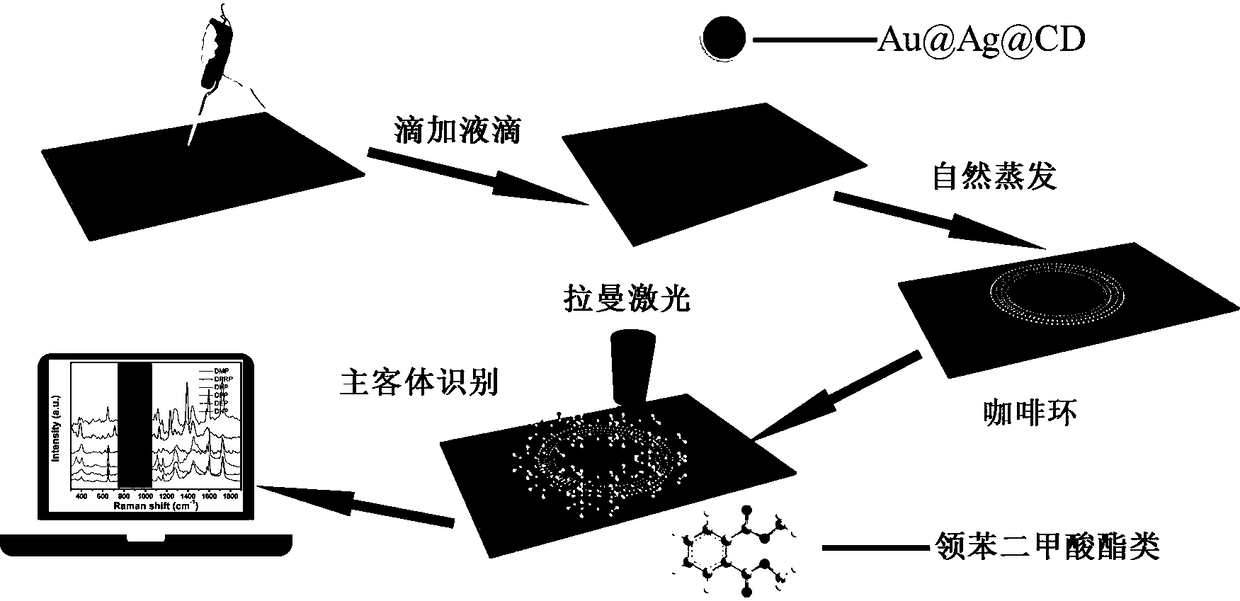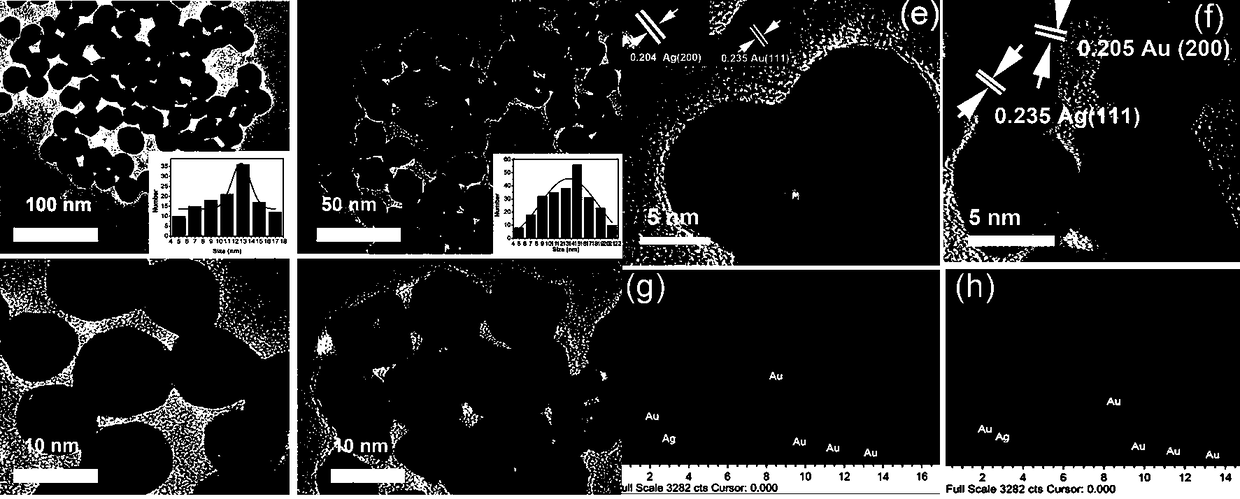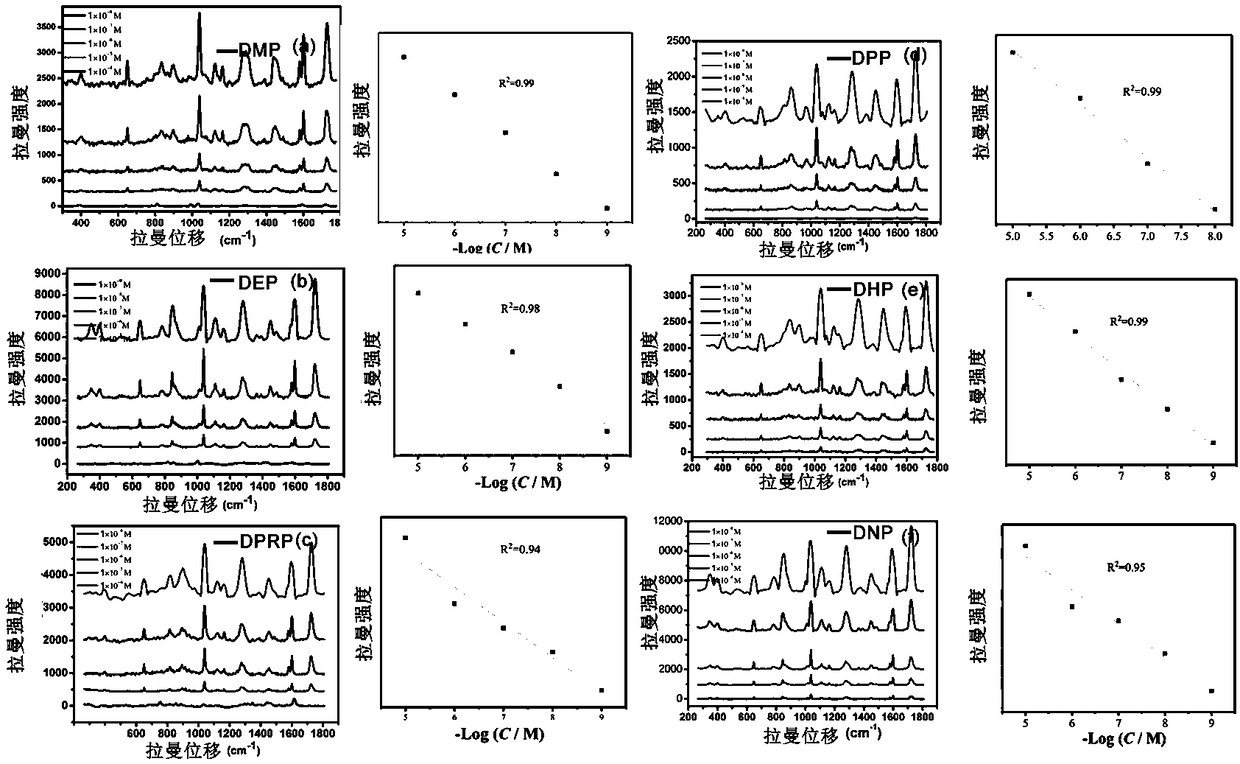Detection method of plasticizer phthalate based on surface enhanced raman spectroscopy
A phthalate ester and surface-enhanced Raman technology, which is applied in Raman scattering, measurement devices, and material analysis through optical means, can solve the difficulties in realizing low-concentration rapid detection and making high-activity Raman substrates , complex and large instruments, etc., to achieve the effect of short detection time, high reproducibility, and simple enrichment method
- Summary
- Abstract
- Description
- Claims
- Application Information
AI Technical Summary
Problems solved by technology
Method used
Image
Examples
Embodiment 1
[0040] Step 1: Preparation of Raman-enhanced active material Au@Ag@β-CD nanosol
[0041] Add 0.4g β-CD into 40mL deionized water, heat it under magnetic stirring to dissolve it, when the temperature rises to 100°C, add 0.4mL HAuCl to the above solution 4 (10 mM) in water. After 2min, add 0.2mL NaOH (1.0M), react for 20min, the color of the solution turns pink, and obtain Au nano sol; then add 0.1mL AgNO to the sol 3 (10mM), reacted for 30min, the color of the sol turned reddish yellow, and the final product was obtained.
[0042] Step 2: Preparation of Raman-enhanced substrate by depositing self-assembled Au@Ag@β-CD nanoparticles using the coffee ring effect
[0043] Soak the silicon wafer in 50% piranha solution for 4 hours, take it out, rinse it with distilled water, dry it with a hair dryer, and then put it in a slide box for use. Take 5 μL of different types 1ⅹ10 -5 Put the standard samples of M phthalates (DMP, DEP, DPRP, DPP, DHP, DNP) into a 1ml centrifuge tube, add ...
Embodiment 2
[0047] Step 1: Preparation of Raman-enhanced active material Au@Ag@β-CD nanosol
[0048] Add 0.4g β-CD into 40mL deionized water, heat it under magnetic stirring to dissolve it, when the temperature rises to 100°C, add 0.4mL HAuCl to the above solution 4 (10 mM) in water. After 2min, add 0.2mL NaOH (1.0M), react for 20min, the color of the solution turns pink, and obtain Au nano sol; then add 0.4mL AgNO to the sol 3 (10mM), reacted for 30min, the color of the sol turned reddish yellow, and the final product was obtained.
[0049] Step 2: Preparation of Raman-enhanced substrate by depositing self-assembled Au@Ag@β-CD nanoparticles using the coffee ring effect
[0050] Soak the slides in 80% piranha solution for 4 hours, take them out, rinse them with distilled water, dry them with a hair dryer, and put them in slide boxes for later use. Take 5 μL of the same species with different concentrations (1ⅹ10 -5 M, 1ⅹ10 -6 M,1ⅹ10 -7 M,1ⅹ10 -8 M,1ⅹ10 -9 M,1ⅹ10 -10 M), take stand...
Embodiment 3
[0054] Step 1: Preparation of Raman-enhanced active material Au@Ag@β-CD nanosol
[0055] Add 0.4g β-CD into 40mL deionized water, heat it under magnetic stirring to dissolve it, when the temperature rises to 100°C, add 0.4mL HAuCl to the above solution 4 (10 mM) in water. After 2min, add 0.2mL NaOH (1.0M), react for 20min, the color of the solution turns pink, and obtain Au nano sol; then add 0.1mL AgNO to the sol 3 (10mM), reacted for 30min, the color of the sol turned reddish yellow, and the final product was obtained.
[0056] Step 2: Preparation of Raman-enhanced substrate by depositing self-assembled Au@Ag@β-CD nanoparticles using the coffee ring effect
[0057] Soak the silicon wafer in 100% piranha solution for 4 hours, take it out, rinse it with distilled water, dry it with a hair dryer, and then put it in a slide box for use. Take 5 μL rhodamine 6G (1ⅹ10 -5 M, 1ⅹ10 -6 M,1ⅹ10 -7 M,1ⅹ10 -8 M,1ⅹ10 -9 M,1ⅹ10 -10 M, 1ⅹ10 -11 M,1ⅹ10 -12 M) Put the standard sample ...
PUM
 Login to View More
Login to View More Abstract
Description
Claims
Application Information
 Login to View More
Login to View More - R&D
- Intellectual Property
- Life Sciences
- Materials
- Tech Scout
- Unparalleled Data Quality
- Higher Quality Content
- 60% Fewer Hallucinations
Browse by: Latest US Patents, China's latest patents, Technical Efficacy Thesaurus, Application Domain, Technology Topic, Popular Technical Reports.
© 2025 PatSnap. All rights reserved.Legal|Privacy policy|Modern Slavery Act Transparency Statement|Sitemap|About US| Contact US: help@patsnap.com



